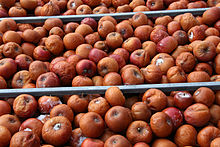- Ice cider
-
Ice cider (also apple icewine or cidre de glace in French; sold as ice apple wine in the United States) is the cider equivalent of ice wine: a fermented beverage made from the frozen juice of apples. There are two main approaches to producing ice cider: cryoconcentration and cryoextraction. Cryoconcentration involves harvesting the fruits late in season and leaving them in fresh storage until late December, when they are pressed and the fresh juice is left to freeze naturally. In January, the concentrated juice begins the process of cold fermentation. Cryoextraction (not the same as the cryoextraction of wine) is similar to the traditional method used to produce ice wine: apples are left on the trees, at the mercy of the weather, until the end of January. They are picked when the temperature hovers around -8°C to -15°C, and then pressed and left to cold ferment for months.
Contents
History
The first claim to commercial ice cider was in 1990 in Dunham, a small town in Québec just north of the Vermont border, by Christian Barthomeuf, a pioneer of Québec's small wine industry. He continues to develop the product in collaboration with La face cachée de la pomme in Hemmingford, Montérégie. Ice cider first became available in stores in 1996. Today it is widely distributed by Québec's government-run chain of liquor stores, the Société des alcools du Québec (SAQ), where it accounts for about 70% of all sales of Quebec products.[1] There are about fifty producers. Most are of very small size, attracted in part by the very low capital costs required to enter the business. In a press release dated 8 June 2008, the SAQ confirmed that "sales of Québec products have increased six-fold in five years at the SAQ, from 2 million in 2002 to just over 12 million dollars in 2007."
The leaders of La Face Cachée de la Pomme, in collaboration with the Association des cidriculteurs artisans du Québec, held discussions with government stakeholders to enable the development of a designation reserved for ice cider in Québec. In 2005, a bill was introduced in committee and subsequently filed.
Definition and standards
Cidre de glace: drinks produced by the fermentation of apple juice, which must have a concentration of sugar before fermentation made solely by the natural cold of at least 30 Brix and whose product has a residual sugar content of at least 130 grams per liter. Finally, the alcohol will be obtained over 7% and less than 13% alcohol by volume. In addition, the specifics must be met:
- no chaptalization;
- no addition of alcohol;
- no artificial apple juice or grape must;
- permission for artificial cold cider (-4 °C) for malic precipitation;
- no additional flavours or colouring;
- no concentration of sugars by methods other than natural cold;
- no use of concentrated apple juice, regardless of origin, whatsoever;
- organoleptic profile of the product corresponds to that of an ice cider as determined by a trade committee;
- the producer of ice cider cultivates the apples;
- the pressing, preparation and bottling of cider ice occur at the site of production.
References
External links
Categories:- Cider
- Fruit wines
- Canadian alcoholic beverages
Wikimedia Foundation. 2010.

